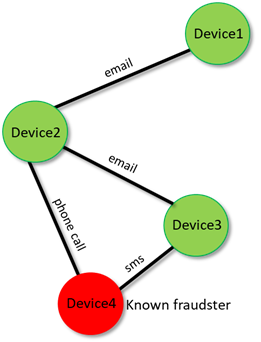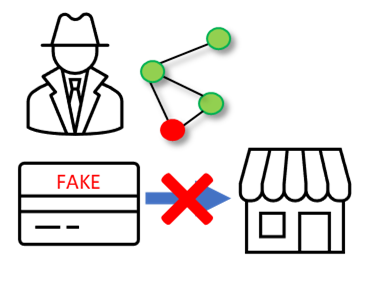
In the rapidly evolving landscape of modern technology and business operations, fraud prevention has become a critical concern for companies across industries. As organizations continue to digitize their operations, fraudsters are finding new and sophisticated ways to exploit vulnerabilities for financial gain.
One powerful tool that has emerged as a game-changer in the fight against fraud is graph analysis, a technique rooted in graph theory that leverages the connections between data points to uncover hidden patterns and relationships. In this article, we delve into the world of graph analysis and its transformative role in fraud prevention.
In a way, the use of graph databases is like employing a fraud prevention network, ultimately using link analysis for fraud detection. Discovering relationships between nodes and edges enables fraud fighters to study those link networks and perform deep fraud analysis that would otherwise be impossible in real time. Let's cover a couple of key terms to know when talking about using graphs for fraud detection.
Graph Database - A graph, in mathematics, is an alternative way of organizing information. A graph database, then, refers to how the graph is stored. Information in a graph is described using relationships between items.
Nodes and Edges - A graph consists of two types of elements: nodes and edges. You can think of the nodes as “nouns” and the edges as “verbs.” For example, a node could be a person, a phone number, an email address, or a physical device (e.g., phone, computer). The edges then represent transfers or interactions between the different nodes.
What Is Link Analysis? What Are Graph Networks?
Link analysis, also known as network visualization, is a technique used to assess and evaluate connections between data points. The visualization of these connections in a graph network enhances the ease and speed of analysis.
A graph network is a visual representation of connections between various types of information, stored in graph databases. These networks consist of nodes, which represent data points such as individuals, businesses, or addresses, and edges, which signify the relationships between these nodes.

The Power of Graph Databases
Graph databases are designed to store and manage graph networks efficiently. They store information in a way that the relationships between data points are as important as the data itself. Unlike traditional databases, which rely on tabular formats, graph databases provide an intuitive and comprehensive view of the connections between different pieces of information. Nodes within a graph database contain attributes or properties, and edges can also possess properties such as start dates, durations, distances, or costs.
Graph Theory: A Different Perspective
At its core, graph theory provides an alternative approach to organizing and understanding information. Instead of the traditional tabular format, graph databases focus on relationships between data points. A graph comprises nodes, the "nouns" in our earlier analogy, and edges, the "verbs."
For instance, nodes could represent individuals, phone numbers, email addresses, or devices, while edges signify interactions or transfers between nodes. This perspective allows for the exploration of complex relationships that might be hidden in traditional data representations.
Advantages of Graph Analysis in Fraud Prevention
The application of graph analysis to fraud prevention offers a range of advantages:
- Intuitive and Easy to Use: Humans are naturally drawn to visualizations, and graph networks capitalize on this. Over half of the brain is dedicated to visual processing, making graph networks inherently easy to understand.
- Insightful and Powerful: Graph analysis can unveil hidden connections between fraudulent entities, enabling the creation of fraudster profiles. This information can then be integrated into machine learning algorithms to enhance fraud prevention strategies.
- Time-Efficient Analysis: Graph networks significantly reduce the manual effort required for scanning and analyzing data. This leads to quicker identification of trends and a real-time understanding of customer behavior and fraudulent activities.
Graph Analysis in Action: Fraud Detection
In the realm of fraud detection, graph analysis plays the role of a detective, unearthing intricate networks of connections. Fraudsters often collaborate in complex underground communities, sharing information and cooperating in their endeavors. They may employ various tactics, such as sharing lucrative opportunities and using intermediaries to carry out fraudulent activities.
Detecting Fraudulent Networks
Graph analysis aids in spotting fraudulent networks through various indicators:
- Rapidly Expanding Networks: Legitimate networks typically grow gradually. Sudden and rapid growth can indicate fraudulent activity.
- Shared Data Points: Genuine customers rarely share the same device, card, or email address. Frauds networks might involve multiple accounts sharing these attributes.
- Frequent Chargebacks: Networks with high occurrences of chargebacks can be indicative of fraud.

Graph Databases in Fraud Detection
Companies like Vesta are at the forefront of leveraging graph technology for fraud prevention. Graph databases allow for real-time visualization of connections, aiding in the identification of associations between individuals or entities.
By running advanced algorithms on graph databases, machine learning capabilities are enhanced, leading to higher accuracy in detecting fraud. Additionally, graph analysis enables the grouping of information related to known fraudsters, making it difficult for them to hide behind multiple identities.
Regionally, or even globally, using graph networks makes a big impact for merchants, payment processors, and financial institutions by uncovering fraud rings simply by using this powerful data analytics technique. Fraud analytics is becoming more sophisticated, and businesses that facilitate transactions should leverage the power of such strong anti-fraud platforms.
The Future of Graph Analysis
As businesses continue to combat evolving fraud techniques, graph analysis will remain a potent weapon in their arsenal. Its ability to uncover hidden connections, visualize complex relationships, and facilitate advanced algorithms positions it as a cornerstone of fraud prevention. Whether in eCommerce, banking, or any industry that deals with data, the application of graph analysis is set to become even more essential in the fight against fraud.
In conclusion, graph analysis presents a paradigm shift in fraud prevention, enabling businesses to gain valuable insights into the connections that fraudsters attempt to conceal. By leveraging the power of graph networks and databases, companies can enhance their fraud detection strategies, save valuable time, and create a safer environment for both themselves and their customers. As technology continues to advance, the adoption of graph analysis will undoubtedly remain a crucial factor in staying one step ahead of fraudsters.
Don't wait any longer--contact us today to learn how the Vesta platform is leading the industry with graph analysis for fraud prevention!
.png)
.png)
%20(1).png)



